ASUS P8Z77-V Deluxe Review - Know Your SKU
by Ian Cutress on May 12, 2012 8:45 AM EST- Posted in
- Motherboards
- Asus
- Z77
Test Setup
| Processor |
Intel Core i7-3770K ES 4 Cores, 8 Threads, 3.5 GHz (3.9 GHz Turbo) |
| Motherboards |
ASRock Z77 Extreme4 ASUS P8Z77-V Pro Gigabyte GA-Z77X-UD3H MSI Z77A-GD65 ASUS P8Z77-V Deluxe |
| Cooling | Intel All-in-One Liquid Cooler |
| Power Supply | OCZ 1250W Gold ZX Series |
| Memory |
GSkill RipjawsZ 4x4 GB DDR3-2400 10-12-12 Kit GSkill TridentX 2x4 GB DDR3-2666 11-13-13 Kit |
| Memory Settings | XMP (1866 9-10-9) |
| Video Cards |
ASUS HD7970 3GB ECS GTX 580 1536MB |
| Video Drivers |
Catalyst 12.3 NVIDIA Drivers 296.10 WHQL |
| Hard Drive | Micron RealSSD C300 256GB |
| Optical Drive | LG GH22NS50 |
| Case | Open Test Bed - CoolerMaster Lab V1.0 |
| Operating System | Windows 7 64-bit |
| SATA Testing | Micron RealSSD C300 256GB |
| USB 2/3 Testing | OCZ Vertex 3 240GB with SATA->USB Adaptor |
Power Consumption
Power consumption was tested on the system as a whole with a wall meter connected to the OCZ 1250W power supply, while in a dual 7970 GPU configuration. This power supply is Gold rated, and as I am in the UK on a 230-240 V supply, leads to ~75% efficiency > 50W, and 90%+ efficiency at 250W, which is suitable for both idle and multi-GPU loading. This method of power reading allows us to compare the power management of the UEFI and the board to supply components with power under load, and includes typical PSU losses due to efficiency. These are the real world values that consumers may expect from a typical system (minus the monitor) using this motherboard.
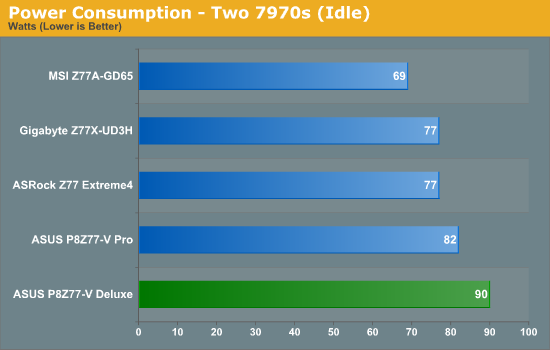
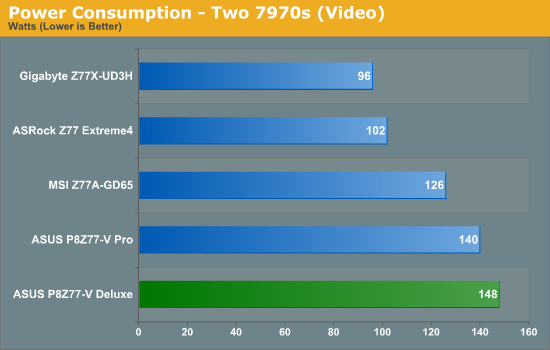
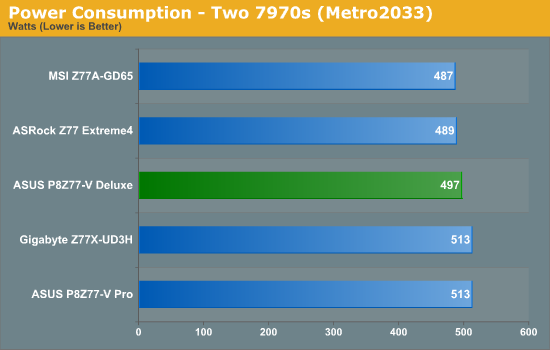
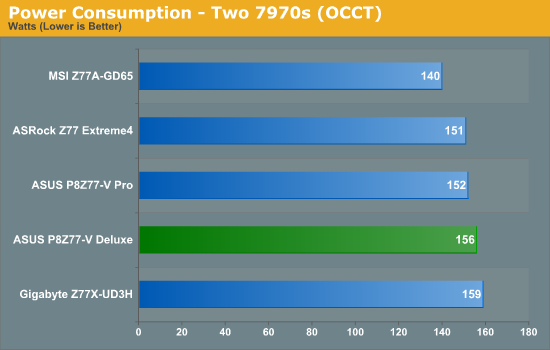
At lower loads, the power consumption on the Deluxe does seem a little high. This is due to ASUS' phase loading, in order to reduce the variation in voltages when lots of power is required instantly. This shows in the 2D benchmarks shown later in this review, which offer superior numbers.
POST Time
Different motherboards have different POST sequences before an operating system is initialized. A lot of this is dependent on the board itself, and POST boot time is determined by the controllers on board (and the sequence of how those extras are organized). As part of our testing, we are now going to look at the POST Boot Time - this is the time from pressing the ON button on the computer to when Windows starts loading. (We discount Windows loading as it is highly variable given Windows specific features.) These results are subject to human error, so please allow +/- 1 second in these results.
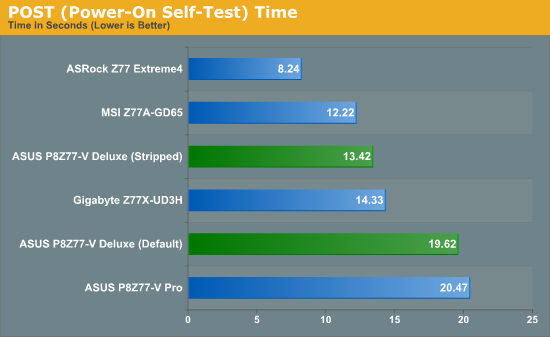
As requested, for future POST tests we will include an additional 'stripped' test, whereby controllers are turned off (USB 3.0, NIC, Audio, SATA Controller). The Deluxe is like the Pro, in that the onboard testing to make sure everything works takes an extra few seconds over other products.
Overclocks
Here at AnandTech we want to provide quick and easy ways to determine if a board is good for you (with in-depth analysis of course). So here is a quick round up of our overclocking results. Overclocks are tested for stability with PovRay and OCCT - while these may not be the most strenuous of stability tests, it does offer a quick check for memory errors under high load (and also balances testing time with getting the next board on for review!).
|
CPU Speed (MHz) |
Voltage (Volts) |
PovRay Peak Temp (ºC) |
OCCT Peak Temp (ºC) |
Notes | |
|
ASRock Z77 Extreme4 |
4700 | 1.175 | 86 | 86 | LLC Level 1 |
|
ASUS P8Z77-V Pro |
4700 | 1.200 | 83 | 86 | PLL Overvoltage enabled |
|
Gigabyte Z77X-UD3H |
4700 | 1.200 | 82 | 86 | LLC Extreme |
|
MSI Z77A-GD65 |
4700 | 1.250 | 90 | - | PLL Overvoltage enabled |
|
ASUS P8Z77-V Deluxe |
4700 | 1.225 | 89 | 84 | PLL Overvoltage enabled |










52 Comments
View All Comments
maximumGPU - Saturday, May 12, 2012 - link
i recently build a pc around an Ivy processor, and that's the motherboard i went for.Very happy with it, and the software bundle you get with Asus mobos is really useful.
One annoyance thought is that the cpu temperature reported in Fan Xpert did not seem to match the temperature readings i get from Real Temp or other software, especially under load. And since fan control is tied to that reading it makes it rather pointless.
Did you encounter that Ian?
Great review too.
Lonyo - Saturday, May 12, 2012 - link
I've noticed that as well, to the point where the numbers in the Asus software don't seem to update properly OR match the numbers in Realtemp, making the Asus software pretty useless for checking temperatures, and something I'm not entirely comfortable with in terms of controlling fan speeds, since it would be based on temperature readings I'm not comfortable with.webs0r - Saturday, May 12, 2012 - link
Run AIDA64 alongside fanXpert. You will find that ASUS uses the sensor named "CPU" rather than the individual core temps.While it reports lower than the core temps, it moves in line with the CPU temperature, and is a good proxy for fan control.
I would not worry about this at all.
So you should put the CPU under various loads and monitor in AIDA where temps get to, and construct your fan profile as you desire to balance the cooling power with noise.
I'm not sure what realtemp reports, it may not report the overall CPU sensor if it is only reporting each core temp.
The ASUS software is not useless/pointless at all.
maximumGPU - Saturday, May 12, 2012 - link
under Prime, both Aida and Asus mobo report 33 deg, while real temp shows 50-52 across all cores, which certainly makes more sense than the other reading.That makes fan controlling based on the number reported by the deluxe pointless.
mdev - Saturday, May 12, 2012 - link
I'm currently preparing to start building my new Ivy Bridge setup, with the ASUS P8Z77-V Pro motherboard.I'm interested to know if this would be the case with the Pro too. Is ASUS aware of this issue?
webs0r - Saturday, May 12, 2012 - link
You are all wrong, it is not pointless!Are you using the latest beta version of AIDA? It will show you both the 4 core sensors AND the CPU sensor.
So on mine (4.4ghz), right now my
CPU = 22
Cores = avg 28
Running IBT
CPU = 54
Core = avg 70
So what does this tell us??
1) In terms of *absolute temperature readings* they are probably all inaccurate to some degree.
2) Of course the die temp is going to be higher than the overall CPU sensor die, they are monitoring different places on the CPU.
3) By looking at the pattern in AIDA, I know that the CPU sensor idles around 25 and scales to 55+ when the cores get HOT (70+). So - I can control the fans with this. It scales in line. It is a proxy for the CPU temp. As good as any. It doesn't matter that it is not equal to the average of the die temps. As long as it goes higher when the CPU gets hotter - you get the same end result? Get it??
If it went the other way or didn't move while the CPU got hot, then that's a problem.
So I made a fan ramp that stays at minimum until 25 deg, ramps slowly until 50 deg and ramps a bit faster until 55 deg, then caps out to the loudest I want the fan to be at 55deg. This gives the exact behaviour I want, thus it is not useless.
althaz - Saturday, May 12, 2012 - link
Ian, it's great to see somebody take on board suggestions from their readers and apply them so quickly!In the Z77 roundup people asked for stripped and default POST times and here they are in the next review just a couple of days later.
Fantastic review all-around and I eagerly await the incoming Intel board reviews (so I can decide what to buy :)).
BlueReason - Sunday, May 13, 2012 - link
I believe he said such tests would be included in the future, not in this review. Not sure how that could be confused with a bar chart of test results, but the mind works in mysterious ways.arvee - Saturday, May 12, 2012 - link
Can you elaborate at all on the thunderbolt support in this? Will an add on card be as good as an integrated solution like on the MSI Z77A-GD80?tyger11 - Saturday, May 12, 2012 - link
I think I heard somewhere taht the add-in card via the TB header is a single channel, and the future mobos with it onboard will be dual channel. I could be misremembering.